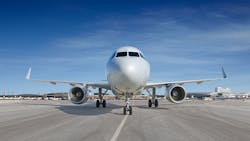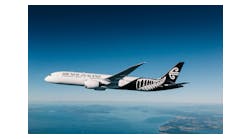American Airlines announced the findings of a first-of-its-kind study on contrail avoidance, with results verified by satellite imagery, aimed at reducing aviation’s environmental impact.
Contrails form when airplanes fly through layers of humidity, and they can persist as cirrus clouds for minutes or hours depending on the conditions. While these extra clouds can reflect sunlight back into space during the day, certain contrails can trap heat within the Earth’s atmosphere at night.
The study, led by Google Research and Breakthrough Energy and with support from American, tested whether it is possible to identify atmospheric zones that are likely to create contrails. The team then determined whether pilots could avoid making contrails in flight when supplied with data regarding the location of these zones.
“American is grateful for the opportunity to work with our partners at Google Research and Breakthrough Energy to help advance the science on contrail avoidance,” said Jill Blickstein, Vice President of Sustainability at American. “The results from this small-scale test are encouraging, and, while clearly there are more questions to answer about how to operationalize contrails avoidance across our industry, we’re excited to have played a role in establishing this first proof point. And we’re looking forward to sharing what we learned with stakeholders in the aviation industry and beyond.”
After collecting large data sets — such as satellite imagery, weather and flight path data — Google Research and Breakthrough Energy used artificial intelligence (AI) to develop contrail forecast maps. A small group of American pilots flew 70 flights over six months, using AI-based predictions to make small modifications to routes that were projected to create contrails.
“Our contrails predictions combine the latest in AI research with massive amounts of satellite imagery, weather data and flight data,” said Juliet Rothenberg, head of product for Climate AI at Google Research. “We now have the first proof point that commercial flights can use these predictions to avoid contrails, as verified in satellite imagery. We’re grateful for our partnership with American Airlines and Breakthrough Energy – together we’ve taken a significant step towards understanding a high-potential climate solution.”
After the test flights, Google Research analyzed satellite imagery and found that flights where pilots used the AI predictions to avoid creating a contrail reduced contrail formation by 54%, as measured by distance, compared to flights where pilots did not use the predictions. This first proof point — albeit on a small number of flights — shows that a commercial flight can verifiably avoid creating a contrail. Additional research is necessary to determine if this success can be replicated and scaled.
“Avoiding contrails might be one of the best ways to limit aviation’s climate impact, and now we have a clear demonstration that it’s possible to do so,” said Marc Shapiro, Director of Breakthrough Energy Contrails. “This study is a great example of what happens when creative, ambitious organizations work together to better understand and solve a tough problem, and we're grateful for American’s and Google’s partnership.”
American is working to make its operations more sustainable with more-fuel efficient aircraft powered increasingly by low-carbon fuel and new technology. To achieve net-zero greenhouse gas emissions by 2050, the airline has set a number of ambitious intermediate targets. Earlier this month, American issued its 2022 Sustainability Report, providing updates on the company’s strategy and progress on key issues over the year, including climate change.





